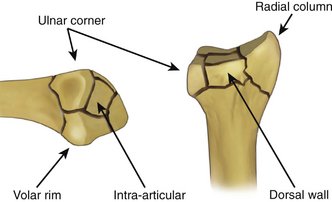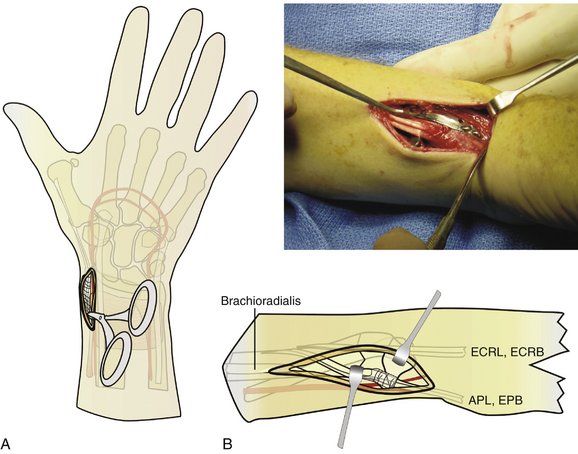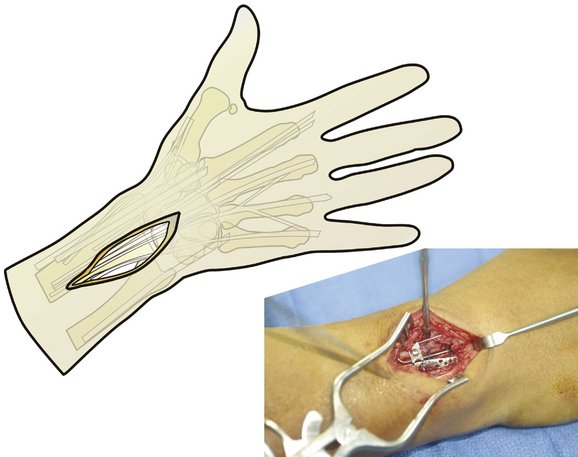CHAPTER 12 Fragment-Specific Fixation of Distal Radius Fractures
Of the various types of distal radius fractures, those with intra-articular extension have the most to gain from operative intervention. Many of these fractures are inherently unstable and not amenable to conservative methods of reduction and cast immobilization. Treatment that fails to correct residual incongruity of the joint and leaves a significant step-off or gap in the articular surface can result in chronic osteoarthritis and pain.1–4 Furthermore, unreduced fragments that alter the geometry and normal kinematics of the radiocarpal or distal radioulnar joint can cause painful movement, restricted motion, and joint instability. Ideally, treatment should be directed at stable restoration of normal anatomy of the articular surface.
Although intra-articular fractures of the distal radius do not occur as a single, homogeneous pattern, the majority of these injuries contain a subset of five basic fracture elements: the radial column, ulnar corner, dorsal wall, volar rim, and free intra-articular fragments (Fig. 12-1). Occasionally, these fracture elements themselves may have further comminution. In addition to these cortical elements, these fractures may have other associated pathological processes, such as compressive damage to the metaphyseal bone, fractures of the distal ulna, and soft tissue injuries of the triangular fibrocartilaginous complex (TFCC), distal radioulnar joint (DRUJ), and radioulnar syndesmosis. In more complex fracture patterns, appropriate treatment of distal radius fractures often must be customized to the specific components and mechanism of the particular injury. Although recently there has been a rise in the popularity of fixed-angle volar plates for the treatment of distal radius fractures, this method of treatment can be inadequate for fractures with small distal fragments or injuries with complex, multiarticular patterns.5 Treatment starts with careful analysis of the injury and initial postreduction radiographs.6 When needed, computed tomography (CT) can supplement standard radiographs to help with the interpretation of the fracture pattern. These topics have been covered in previous chapters.
Fragment-specific fixation is a treatment approach in which each independent major fracture fragment is stabilized with an implant specifically designed for that particular fracture element (Fig. 12-2).7–10 One objective of fragment-specific fixation is to restore a stable, anatomical joint surface by direct and independent fixation of each major fracture fragment. As a general rule, fragment-specific fixation is a load-sharing construct in which each fracture element is pieced back together into a unified composite structure. Fragment-specific implants are intentionally designed to be extremely low profile and conform to the local surface topography at the site of application, avoiding the need for bulky plates that can irritate tendons or large distal screw holes that can cause further comminution of small distal fragments. Another goal of treatment is to achieve enough stability to allow motion immediately after surgery.
Fragment-Specific Implants
Although the primary function of the radial pin plate is to provide rigid fixation of the radial column, the radial pin plate has a secondary role that can also help with stabilization of many articular fractures. Although the plate is thin, because it is applied along the plane of the radial border, it is extremely stiff in resisting bending moments caused by flexion and extension movements of the wrist. Moreover, the radial pin plate is slightly overcontoured to the curve of the radial border and flattens like a leaf spring against the bone as it is secured to the proximal fragment. This causes the plate to push the distal fragment toward the ulna, locking intra-articular fragments in place and improving DRUJ stability by seating the ulnar head within the sigmoid notch of the radius. Because this property of the radial pin plate is quite effective in securing intra-articular fragments in whatever position they happen to be, it is generally a good idea to ensure that articular fragments are first fully reduced before securing the radial pin plate to the proximal fragment.
The volar buttress pin is an implant that is designed for unstable fragments that involve the volar rim. Fragmentation of the volar rim is usually the result of either a volar shear or axial loading mechanism. If the volar rim fragment is small, plate fixation can be inadequate; flexion or axial loading of the wrist can cause this fragment to displace over the edge of the plate, carrying the carpus with it into the palmar soft tissues. Alternatively, if the volar rim fragment is dorsiflexed with a depressed teardrop angle, plate fixation may further aggravate the angular deformity by pushing up on the volar surface of the fragment. The volar buttress pin is often a simple, effective solution for these complicated problems. Like the dorsal buttress pin, the legs of the volar buttress pin can be driven like a clip into the volar rim fragment and the implant then used as a joystick to manipulate and correct the position and angular deformity of the fragment. Once reduction is achieved, the wire form is simply fixed proximally with two screws and washers or a small wire plate.
Surgical Approaches
Radial Palmar Exposure
The surgical approach to apply a radial pin plate and volar buttress pin can be called “radial palmar” not only because of the implant locations but also because of the incision (Fig. 12-3). Typically, a 7-cm linear incision is made on the “radial palmar” aspect of the distal forearm, extending proximally from the level of the radial styloid.11 The incision is about halfway between the true midlateral line of the forearm and its palmar surface. Another way to situate the incision is to feel the radial artery pulse and make the incision a little radial to this landmark.
The brachioradialis should be released for two reasons. Its insertion obscures access to the radial column fracture site and it must be released completely to allow mobilization of this segment. Additionally, the brachioradialis produces a deforming force on the radial column fracture and release of this tendon insertion reduces the tendency for subsidence of the fracture. The brachioradialis insertion becomes the floor of the first extensor compartment, and at the margins of the radial styloid prominence it blends into the first extensor compartment tendon sheath.
Dorsal Exposure
Access to the dorsal aspect of the distal radius is required to address dorsal wall and ulnar corner fragments, as well as impacted free articular fragments. A dorsal exposure can also be used to aid in the reduction of particularly impacted radial styloid fragments or help elevate and use bone grafts in depressed articular segments. The dorsal incision is longitudinal and typically 5 cm long, located about 1 cm radial to the ulnar head and ending about 1 cm distal to the radiocarpal joint line (Fig. 12-4). Although there are fewer sensory nerves deep to this incision compared with the radial palmar region, care should be taken to pursue blunt dissection until the extensor retinaculum is encountered. There are usually a few large veins that can be either retracted or cauterized. The retinaculum overlying the fourth extensor compartment is next opened longitudinally, and the common digital extensor (and extensor indicis proprius and extensor digiti quinti) tendons can be retracted ulnarly to expose the dorsal metaphyseal area. The extensor pollicis longus should be mobilized by releasing the retinaculum proximally in a longitudinal fashion; often the retinaculum overlying Lister’s tubercle can be left in place and the extensor pollicis longus can be satisfactorily retracted radially. Occasionally, it can be helpful to fully release the extensor pollicis longus from Lister’s tubercle, thereby allowing it to be retracted farther radially. This is particularly helpful when the dorsal wall fragment extends radially and involves Lister’s tubercle as part of the fracture pattern.
Exposure of the dorsal fracture fragments requires patience and attention to detail. Although this part of the surgery does not need to take more than 10 minutes, two critical issues must be addressed to allow placement of the appropriate hardware. First, the soft tissue around the dorsal fragments must be released enough to enable both good direct visualization as well as adequate mobility of the individual fragments so that they can be reduced. Use of a small elevator is helpful to pry apart any hematoma, incipient fracture callus, and periosteal attachments so that dorsal fracture pieces can be clearly identified. Sometimes it is even necessary to free up the retinacular extensions of the second compartment tendons (wrist extensors) as well as transpose the extensor pollicis longus radially so that the dorsal wall and region around Lister’s tubercle can be more easily treated.
Fracture Patterns
Extra-articular Fracture
Internal fixation of the metaphyseal fracture segment can be accomplished through a single, radial palmar incision. A secure construct and anatomical reduction can be achieved by using a radial pin plate and a volar buttress pin (Fig. 12-5). The radial pin plate restores radial column length, and the volar buttress pin prevents dorsal or palmar translation. The volar buttress pin also has the effect of anatomically reducing the thick cortical margin on the palmar surface of the radius, which helps resist the tendency for proximal subsidence of the metaphyseal segment. It should also be noted that a key effect of the radial pin plate is application of a medially directed vector on the metaphyseal segment, which not only aids in restoration of radial length but just as importantly reduces the DRUJ and allows the cortical perimeter of the distal radius to be anatomically reduced, adding stability to the whole construct. This fracture can be visualized like the top of a rectangular box that has been sawed off and the box top then slides a little sideways and has one or two sides overhanging the base. Exact realignment of the box top allows all four sides of the top to contact the base edges and provides four sides of support.












